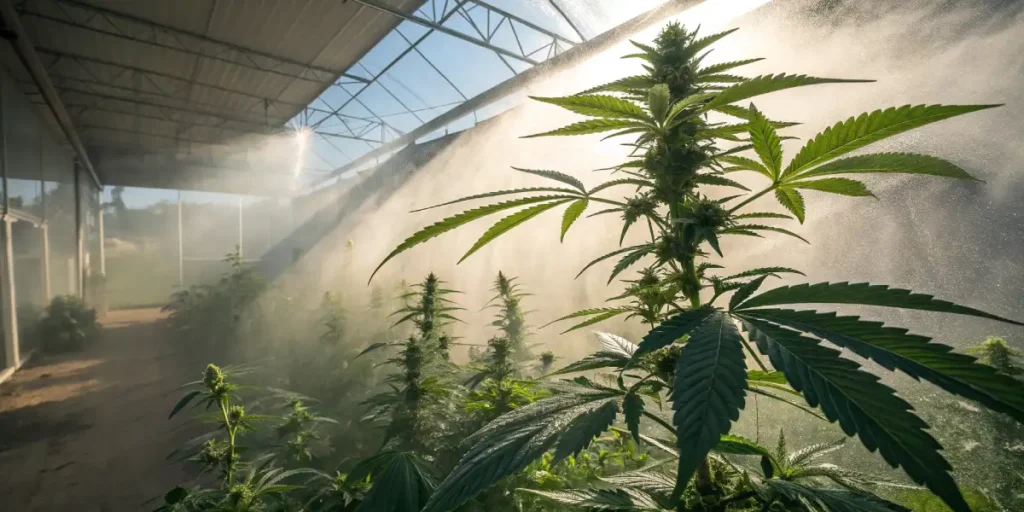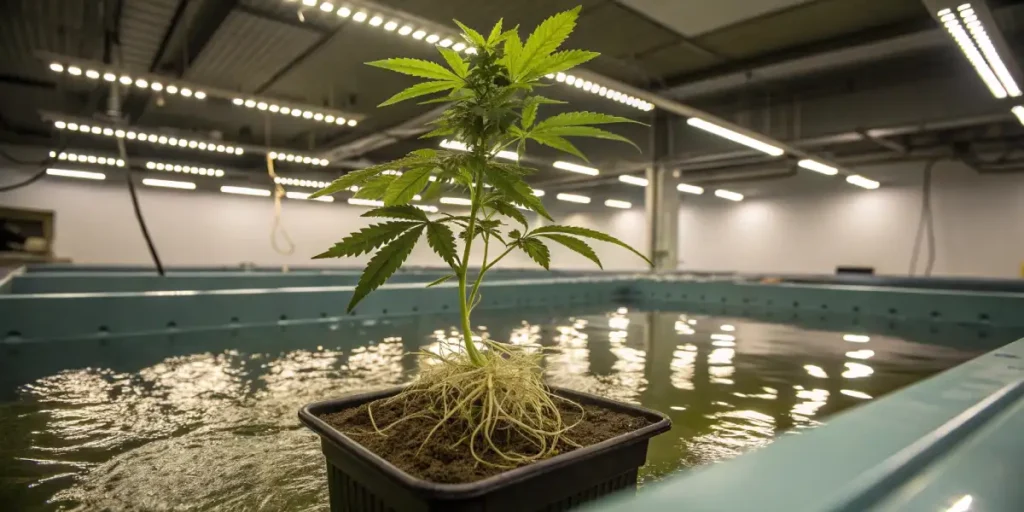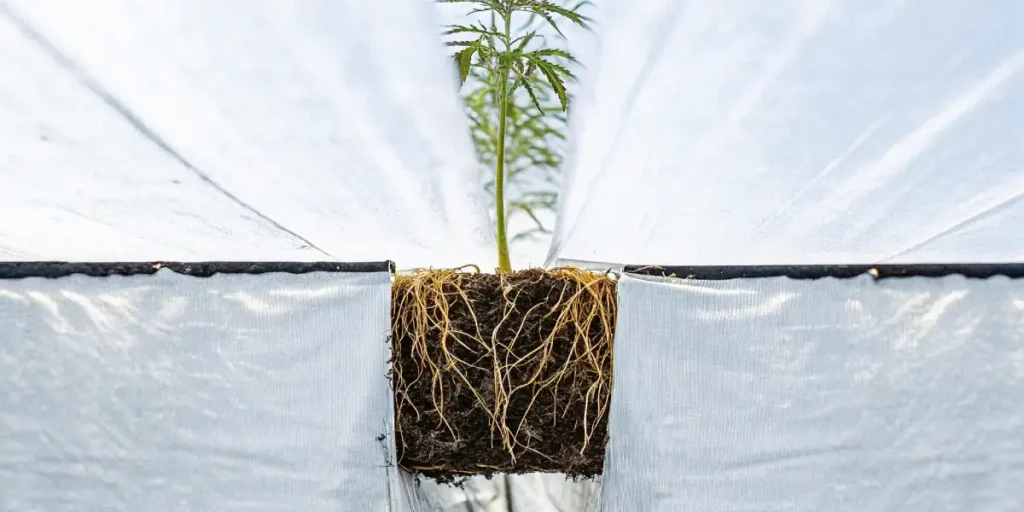
Apoplastic Pathway in Cannabis Nutrient Transport
The Apoplastic Pathway in Cannabis Nutrient Transport is a crucial process that every grower should know. This transport system in plants aids in the movement of water and nutrients from the roots to the other parts of the plant. It operates in the spaces between the cells, making it a fast and efficient transport method.
For first-time cannabis seed buyers and seasoned growers, getting acquainted with this process can significantly improve how you handle your plants. It can influence the quality of your yield and the overall growth of the cannabis plants.
Recommended Strains
Banana Cream
|
|
THC | 28% - 30% (High) |
|
|
Type | Feminized |
|
|
Yield | Medium |
|
|
Phenotype | 70% Indica / 30% Sativa |
CBD Cream Cheese (1:1)
|
|
CBD | 18% – 22% (High) |
|
|
Type | CBD Feminized |
|
|
Yield | Medium |
|
|
Phenotype | 45% Indica / 55% Sativa |
Think of this pathway as a highway system that carries nutrients and water from the roots upwards. The nutrients taken from the soil are carried through this ‘highway’ to reach the different parts of the plant. This process significantly impacts the plant’s growth, health, and productivity.
Comprehending this pathway can be a game-changer for cannabis cultivators. The pathway’s efficiency can determine how well the plant absorbs, uses, and distributes nutrients, thus having a direct impact on the plant’s wellness and productivity.
Impacts of Apoplastic Pathway on Cannabis Nutrient Transport
The Apoplastic Pathway in Cannabis Nutrient Transport plays a significant role in the overall health and productivity of your cannabis plants. It affects how efficiently the nutrients and water are absorbed and distributed throughout the plant. Essentially, a well-functioning pathway ensures that the nutrients reach where they are needed most.
For instance, if you’re growing the Gorilla Glue #4 strain from Blimburn Seeds, an efficient apoplastic pathway ensures that the nutrients reach all parts of the plant. This helps in maximizing the growth potential of the strain, leading to a high-quality yield.
Moreover, its function in cannabis growth extends beyond just nutrient and water transport. It can also help in the management of stress and disease tolerance, thereby boosting the overall well-being and resilience of your cannabis plants. A healthy and well-nourished plant, in the end, is more likely to produce a higher yield.
The impacts on cannabis nutrient transport can also be seen in the plant’s response to varying environmental conditions. For instance, in conditions of drought or water stress, a well-functioning system can help in effective water management, thereby aiding the plant’s survival and growth.
Effects of Apoplastic Pathway on Nutrient Transport in Cannabis Cultivation
The apoplastic pathway has several effects on nutrient transport in cannabis cultivation. First, it affects the speed at which the nutrients are transported from the roots to the other parts of the plant. A well-functioning system results in faster nutrient transport, which in turn, leads to faster growth and development of the plant.
Second, the apoplastic pathway also influences the efficiency of nutrient uptake. It ensures that the nutrients absorbed by the roots are effectively transported to the rest of the plant. This is crucial in growing strains like Granddaddy Purple, which require a lot of nutrients to grow and produce high-quality buds.
Another significant effect on nutrient transport in cannabis cultivation is its influence on the plant’s metabolic processes. By ensuring an efficient supply of nutrients, the pathway can aid in the optimal functioning of various metabolic processes, including photosynthesis, respiration, and protein synthesis, which are crucial for the plant’s growth and productivity.
This pathway also plays a significant role in maintaining the plant’s turgidity and structural integrity. By regulating the transport of water and dissolved nutrients, it helps in maintaining the plant’s cell turgidity, thus contributing to the overall structural rigidity and upright growth of the cannabis plant.

Promos & Deals
Improving Cannabis Nutrient Transport through Apoplastic Pathway
Improving nutrient transport can significantly enhance the efficiency of nutrient uptake in your cannabis plants. There are several ways you can achieve this. First, ensure that the roots are healthy and free from any disease or infection. Healthy roots are more efficient in absorbing nutrients and transporting them throughout the plant.
Second, provide the right amount of water and nutrients to your plants. Overwatering or over-fertilizing can lead to nutrient lockout, which can affect the functioning of the apoplastic pathway. Therefore, it’s important to maintain the right balance to ensure the efficient functioning of this transport system.
Improving Cannabis Nutrient Transport can also be achieved by practicing proper irrigation techniques and maintaining optimal soil conditions. This includes avoiding waterlogged conditions, maintaining proper aeration and drainage, and ensuring a suitable soil pH range, as these factors can significantly influence the transport efficiency and functioning.
Another way to enhance the apoplastic pathway’s efficiency is by regularly monitoring and adjusting the nutrient solution’s composition and concentration. This can help ensure that the nutrients are readily available and easily absorbable, thereby facilitating efficient nutrient transport and uptake.
Practical Steps to Enhance Apoplastic Pathway Function
- Regularly check the roots of your plants for any signs of disease or infection. Use organic methods to treat any root diseases.
- Ensure that you’re providing the right amount of water to your plants. Overwatering can lead to root rot, which can affect nutrient transport.
- Use a high-quality nutrient solution. The nutrients should be easily absorbable by the roots to ensure efficient transport through the apoplastic pathway.
- Regularly monitor the pH levels of your soil or growing medium. The pH level can affect nutrient availability and absorption.
- Choose cannabis strains that are known for their efficient nutrient uptake, like the Cream Caramel strain from Blimburn Seeds.
By following these steps, you can enhance the functioning of the system, leading to healthier and more productive cannabis plants.
Apart from these, incorporating practices like crop rotation and companion planting can also help in improving the system’s function. These practices can aid in maintaining soil health, promoting beneficial microbial activity, and preventing nutrient depletion, thereby contributing to the system’s efficiency and effective nutrient transport.
Furthermore, using high-quality organic fertilizers and compost can also help improve the system’s functioning. These organic amendments can provide a steady supply of essential nutrients, enhance soil texture and structure, and promote beneficial soil microorganisms, thereby aiding in efficient nutrient transport and uptake.

FAQs
What is the Apoplastic Pathway in Cannabis Nutrient Transport?
The transport system in plants aids in the movement of water and nutrients from the roots to the other parts of the plant. It operates in the spaces between the cells, making it a fast and efficient transport method.
It is crucial for the overall growth and productivity of cannabis plants as it influences how efficiently the nutrients and water are absorbed and distributed throughout the plant. A well-functioning system ensures that the nutrients reach where they are needed most.
Simply put, the Apoplastic Pathway in Cannabis Nutrient Transport is a crucial process in the plant’s life cycle. It influences every aspect of the plant’s growth and development, from seed germination and root development to flowering and bud formation, thus playing a significant role in determining the quality and quantity of your cannabis yield.
Knowledge can also help you address any nutrient-related issues in your cannabis plants more effectively. By identifying and rectifying any disruptions in the pathway, you can ensure that your plants remain healthy and productive throughout their growth cycle.
How does the Apoplastic Pathway affect Cannabis Growth?
The apoplastic pathway significantly affects cannabis growth by regulating the transport of water and nutrients. It affects the speed at which the nutrients are transported from the roots to the rest of the plant, the efficiency of nutrient uptake, and the plant’s response to environmental conditions.
By ensuring efficient nutrient transport, this pathway can help maximize the growth potential of your cannabis plants, leading to healthier plants and better yields.
Furthermore, this pathway also plays a key role in maintaining the plant’s overall vitality and vigor. By ensuring a steady and efficient supply of nutrients, it helps to support the plant’s metabolic activities, aids in energy production, and contributes to the plant’s growth and development, thereby enhancing the plant’s overall health and vigor.
Moreover, a well-functioning pathway can also aid in the plant’s stress management. By regulating the transport of water and nutrients, it can help the plant cope with various types of stress, including drought, salinity, and nutrient deficiencies, thereby enhancing the plant’s resilience and survival chances.
How can I improve the Apoplastic Pathway in my Cannabis Plants?
You can improve the apoplastic pathway in your cannabis plants by ensuring that the roots are healthy and free from any disease or infection. Providing the right amount of water and nutrients and maintaining the right pH levels can also enhance the functioning of this transport system.
Choosing cannabis strains known for their efficient nutrient uptake, like the Cream Caramel strain from Blimburn Seeds, can also help improve nutrient transport in your plants.
Additionally, regular pruning and trimming can also help in enhancing the plant’s nutrient transport system. By removing dead or diseased parts, you can ensure that the nutrients are directed to the healthy parts of the plant, thereby improving nutrient transport and overall plant health.
Finally, using beneficial microbes like mycorrhizal fungi can also aid in improving nutrient absorption and transport in your cannabis plants. These microbes can form a symbiotic relationship with the plant’s roots, enhancing nutrient absorption and transport, thus contributing to the overall health of the plant.
Can the Apoplastic Pathway affect the Quality of my Cannabis Yield?
Yes, the movement of water and nutrients through the plant can significantly affect the quality of your cannabis yield. By ensuring efficient nutrient transport, it helps the plant grow and develop properly, leading to high-quality buds. Strains like Gorilla Glue #4, Granddaddy Purple, and OG Kush, all available at Blimburn Seeds, can benefit from efficient nutrient transport.
However, factors like overwatering or over-fertilizing can lead to nutrient lockout, which can affect the functioning of the plant’s nutrient uptake system and the quality of your yield. Therefore, it’s important to maintain the right balance of nutrients and water.
Moreover, the apoplastic pathway’s efficiency can also influence the plant’s terpene and cannabinoid profile, which are crucial determinants of the cannabis yield’s quality. By ensuring efficient nutrient transport, the pathway can aid in the synthesis of these compounds, thereby enhancing the yield’s potency, aroma, and flavor.
Lastly, the plant’s disease resistance and stress tolerance can also influence, which can indirectly affect the quality of your cannabis yield. A well-nourished and resilient plant is less prone to disease and stress, thereby leading to a healthier plant and a higher-quality yield.
Is the Apoplastic Pathway only important for Cannabis Plants?
While this article focuses on the Apoplastic Pathway in Cannabis Nutrient Transport, this transport system is crucial for all types of plants. It plays a significant role in the overall health and productivity of any plant by ensuring efficient nutrient and water transport.
So, whether you’re growing cannabis plants or any other type of plant, comprehending and improving the water and nutrient transport systems can significantly enhance your gardening skills and the health of your plants.
Moreover, the principles and practices mentioned here for improving nutrient transport can be applied to other plants as well. So, whether you’re a home gardener growing vegetables in your backyard or a commercial farmer growing crops on a large scale, grasping the importance and function of nutrient transport can greatly benefit your gardening or farming practices.
Overall, it is a key player in the plant’s nutrient and water transport system. By recognizing its function and ways to enhance its efficiency, you can ensure the healthy growth and development of your plants, regardless of the type of plant you’re growing.




















